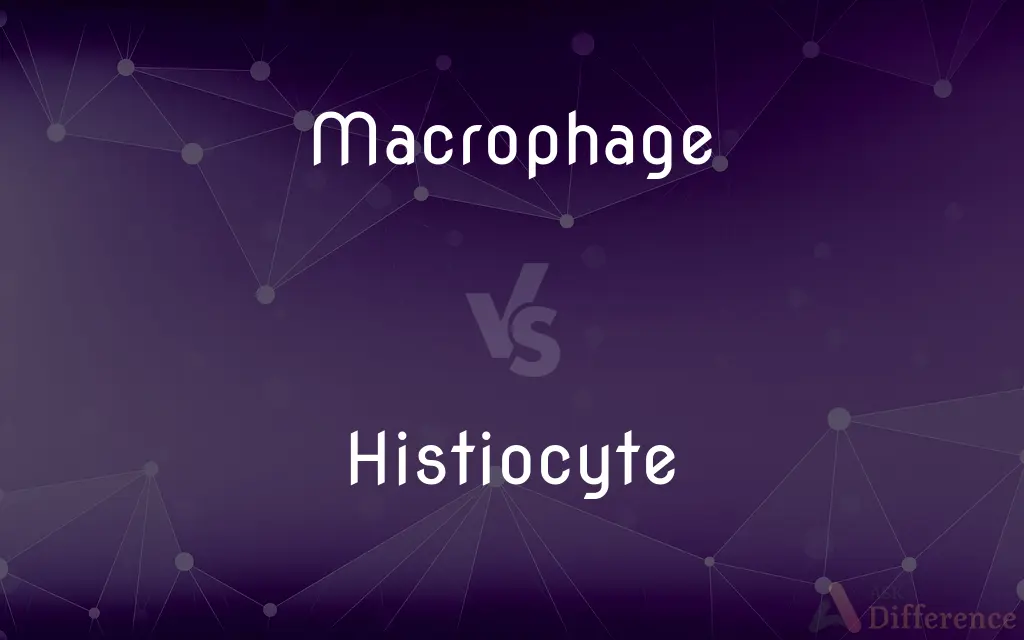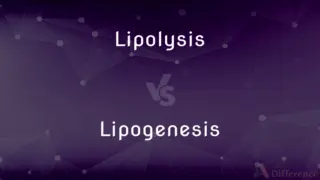Macrophage vs. Histiocyte — What's the Difference?
By Tayyaba Rehman & Maham Liaqat — Updated on March 29, 2024
Macrophages are immune cells that engulf pathogens, while histiocytes are a type of macrophage found in connective tissue, specializing in the removal of waste and foreign substances.

Difference Between Macrophage and Histiocyte
Table of Contents
ADVERTISEMENT
Key Differences
Macrophages are versatile cells in the immune system, known for their ability to phagocytize (engulf and digest) pathogens, dead cells, and cellular debris. Histiocytes, on the other hand, are a specific type of resident macrophage found primarily in connective tissues, where they play a crucial role in both the immune response and tissue maintenance by clearing away dead cells and foreign material.
Macrophages are found throughout the body, in almost all tissues and organs, adapting to their local environment and performing tasks that are critical to both innate and adaptive immunity. Histiocytes, while being a subset of macrophages, are particularly associated with the histological structure of tissues, contributing to the health and stability of connective tissues.
The function of macrophages extends beyond simply engulfing unwanted materials; they also play significant roles in antigen presentation, cytokine production, and the initiation of inflammation. Histiocytes, while they can perform these functions, are more focused on tissue homeostasis and the localized response to injury or infection within connective tissues.
The term "macrophage" encompasses a wide range of cell types and states, reflecting the cell's plasticity and ability to respond to various signals and conditions. Histiocytes represent a more defined and specialized group within this broad category, highlighting the diversity of roles that macrophages can play within different tissues.
In clinical and pathological contexts, the distinction between macrophages and histiocytes can be important. Diseases involving macrophages, such as macrophage activation syndrome, can affect the body systemically, whereas histiocytic disorders might manifest more specifically within certain tissues, reflecting the localized nature of histiocytes.
ADVERTISEMENT
Comparison Chart
Definition
Immune cells that engulf pathogens and debris.
Type of macrophage found in connective tissue.
Location
Throughout the body in various tissues.
Primarily in connective tissues.
Functions
Phagocytosis, antigen presentation, cytokine production.
Tissue maintenance, removal of waste and foreign material.
Role in Immunity
Innate and adaptive immune responses.
Localized tissue response and maintenance.
Clinical Significance
Involved in a variety of immune responses and diseases.
Associated with specific tissue-related disorders.
Compare with Definitions
Macrophage
Key players in the body’s immune response, capable of activating other immune cells.
Macrophages present antigens to T cells to initiate an immune response.
Histiocyte
Macrophages located in connective tissues, involved in removing waste and pathogens.
Histiocytes in the skin help to clear infection by engulfing bacteria.
Macrophage
Involved in wound healing by removing dead cells and promoting tissue repair.
After an injury, macrophages help clean the wound area and stimulate the healing process.
Histiocyte
Can accumulate in certain diseases, leading to histiocytosis.
Langerhans cell histiocytosis is a condition where histiocytes accumulate abnormally.
Macrophage
Immune cells that engulf and digest cellular debris, foreign substances, and pathogens.
Macrophages in the spleen filter blood and remove old red blood cells.
Histiocyte
Participate in the immune system’s response to foreign substances within specific tissues.
Histiocytes in the lungs can engulf inhaled particles that could be harmful.
Macrophage
Can differentiate into specialized forms based on tissue and signals.
In the liver, macrophages become Kupffer cells, which are involved in detoxifying blood.
Histiocyte
Essential for tissue homeostasis and repair.
After tissue damage, histiocytes help in the cleanup process, preparing the site for healing.
Macrophage
Play a role in the development of inflammatory diseases when dysregulated.
Overactive macrophages can contribute to chronic inflammation in diseases like arthritis.
Histiocyte
Act as sentinels in tissues, responding to local injury or invasion.
In response to a splinter, histiocytes would be among the first cells to respond and attempt to remove it.
Macrophage
A large phagocyte.
Histiocyte
A histiocyte is a vertebrate cell that is part of the mononuclear phagocyte system (also known as the reticuloendothelial system or lymphoreticular system). The mononuclear phagocytic system is part of the organism's immune system.
Histiocyte
A macrophage or dendritic cell that is usually immobile and is found in organs and tissues.
Histiocyte
(biology) a macrophage, derived from bone marrow, found in connective tissue
Histiocyte
A macrophage that is found in connective tissue
Common Curiosities
Are all histiocytes involved in disease processes?
Not all histiocytes are involved in disease; many perform vital functions in tissue maintenance and repair under normal conditions.
What role do histiocytes play in cancer?
Histiocytes can influence cancer progression through their roles in immune surveillance, inflammation, and tissue remodeling, potentially affecting tumor growth and metastasis.
What is histiocytosis and how is it related to histiocytes?
Histiocytosis refers to disorders characterized by the abnormal proliferation of histiocytes, which can form tumors or infiltrate tissues, leading to damage and disease.
How are macrophages activated?
Macrophages can be activated by various stimuli, including microbial products, damaged cells, and cytokines, leading to different functional states tailored to specific threats or tasks.
What distinguishes histiocytes in the immune response?
Histiocytes are distinguished by their specific location in connective tissues and their specialized roles in local immune responses and tissue maintenance.
How do histiocytes and macrophages interact with other immune cells?
They interact with other immune cells by presenting antigens, secreting cytokines, and stimulating or regulating the activity of T cells, B cells, and other immune cells, facilitating a coordinated immune response.
Can histiocytes present antigens like other macrophages?
Yes, histiocytes can present antigens to T cells, participating in the adaptive immune response, similarly to other macrophages.
What makes macrophages different from histiocytes?
Macrophages are a broad category of immune cells with diverse roles throughout the body, whereas histiocytes are a specific type of macrophage located in connective tissues, focusing on tissue health and stability.
Can histiocytes be found outside of connective tissues?
While histiocytes are primarily associated with connective tissues, macrophages, including those similar to histiocytes, can adapt to various environments across the body.
How do macrophages contribute to autoimmune diseases?
Macrophages can contribute to autoimmune diseases by presenting self-antigens to T cells, promoting inflammation, and participating in the destruction of body tissues.
Can macrophages and histiocytes repair tissue?
Yes, both macrophages and histiocytes play crucial roles in tissue repair and regeneration by clearing debris, promoting resolution of inflammation, and supporting tissue remodeling.
What are the implications of macrophage diversity for treatment of diseases?
Understanding macrophage diversity, including histiocytes, can lead to targeted therapies that modulate their functions, potentially treating or preventing inflammatory diseases, cancer, and tissue damage.
Share Your Discovery

Previous Comparison
Lipolysis vs. Lipogenesis
Next Comparison
Solo vs. SingleAuthor Spotlight
Written by
Tayyaba RehmanTayyaba Rehman is a distinguished writer, currently serving as a primary contributor to askdifference.com. As a researcher in semantics and etymology, Tayyaba's passion for the complexity of languages and their distinctions has found a perfect home on the platform. Tayyaba delves into the intricacies of language, distinguishing between commonly confused words and phrases, thereby providing clarity for readers worldwide.
Co-written by
Maham Liaqat















































